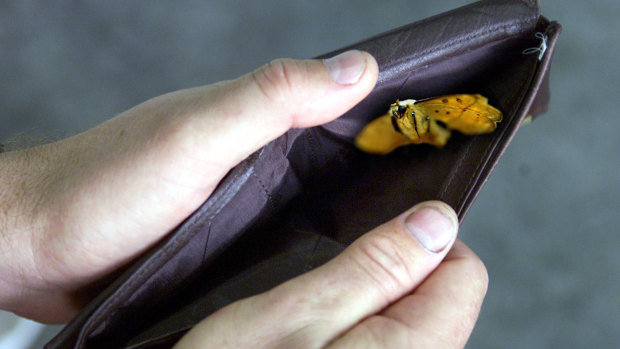- Analysis
- Politics
- Federal
- Household debt
This was published 1 year ago
Australians have been dipping into their piggy banks just to make ends meet
By Shane Wright
One set of numbers can change an entire economic narrative – and not for the better.
Just a month ago, the Reserve Bank was noting that household savings were increasing, a sign that people were socking away cash in their bank accounts to take advantage of higher interest rates.

Household savings are much lower than believed, in a sign people are struggling to make ends meet.Credit: Tanya Lake
So confident was it, the bank revised up its forecasts for the nation’s household savings ratio – the proportion of net disposable income that is not consumed by households – in its most recent outlook on the economy, from 0.9 per cent to 3.2 per cent for the final three months of 2023.
By the middle of this year, it reckoned the savings rate would still be about 3.2 per cent before increasing by year’s end.
But that version of the economy took a battering on Wednesday when the Australian Bureau of Statistics said nope, household savings are actually much, much lower than we thought.
It revised the household savings ratio all the way back to the start of last year. In the December quarter, instead of the RBA’s 3.2 per cent, the ABS now puts the rate at 1.6 per cent before falling to 0.9 per cent in the first three months of this year.
In the September quarter of last year, when many Australians discovered they owed the Tax Office cash because of the end of the low- and middle-income tax offset, it was just 0.2 per cent. The last time a 0.2 per cent savings rate was recorded was in late 2007.
For years, we’ve been told Australians had saved up cash during the COVID pandemic, which they’ve been spending, adding to inflationary pressures. But Westpac’s economists, in light of the new figures, reckon that instead of drawing down about 23 per cent of their $255 billion in additional savings that was put away during the pandemic, the real figure is about 45 per cent.
In dollars and cents, that’s about $56 billion, or almost what the federal government will spend on the age pension in the coming year.
And that $56 billion hasn’t gone to increasing the volume of goods and services being bought by households. They’ve used it to keep up with price increases.
In other words, to keep buying the same amount of stuff, Australians are dipping into their piggy banks, jam jars and online accounts to make ends meet.
The Commonwealth Bank’s head of Australian economics, Gareth Aird, believes these excess savings, outside of those that in mortgage offset and redraw facilities, will be gone by year’s end.
The misread on the state of households savings just highlights the delicate situation in which the economy finds itself.
Growth at 0.1 per cent is abysmal. GDP per capita has fallen by 1.6 per cent since it peaked in mid-2022. Outside a deep recession, you don’t see that sort of fall in per capita GDP.
Net national disposable income per person has dropped by $656 a quarter or about 3.6 per cent over the same period.
Every one of those figures screams “economy in trouble”.
As KPMG chief economist Brendan Rynne noted, the economy is a “heartbeat away from being in a recession”.
All of which puts extra pressure on the July 1 tax cuts (which, remember, are supported by both sides of politics).
If households hold back their spending, or only spend on essentials and put whatever is left over into the household jam tin, then the economy should pick up momentum through the second half of the year. If inflation edges down, then an interest rate cut before Christmas is still a fair chance.
But if households, finally given some relief, rush out and spend, then the Reserve Bank may feel inclined to pull the trigger on another interest rate rise.
Not even an ambulance full of economic paramedics would be able to resuscitate the patient.
Cut through the noise of federal politics with news, views and expert analysis. Subscribers can sign up to our weekly Inside Politics newsletter.